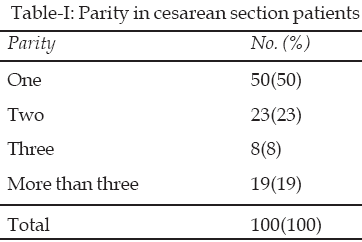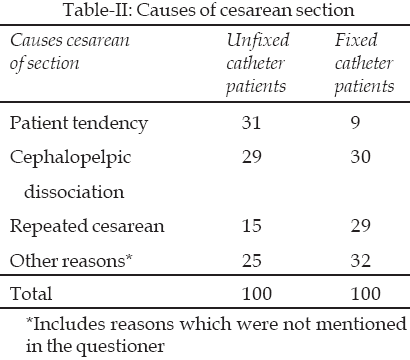|
|
||||
|
Published by : PROFESSIONAL MEDICAL PUBLICATIONS |
||||
|
ISSN 1681-715X |
||||
|
||||
|
- |
||||
|
ORIGINAL ARTICLE |
||||
|
- |
||||
|
Volume 25 |
April - June 2009 (Part-I) |
Number 2 |
||
|
|
||||
|
|
||||
|
|
||||
|
Published by : PROFESSIONAL MEDICAL PUBLICATIONS |
||||
|
ISSN 1681-715X |
||||
|
||||
|
- |
||||
|
ORIGINAL ARTICLE |
||||
|
- |
||||
|
Volume 25 |
April - June 2009 (Part-I) |
Number 2 |
||
|
|
||||
|
|
||||
Fixation and unfixation of Folley catheter in
cesarean section, a comparative study
Mojgan Barati1, Mohamad Jafari R2, Moramezi F3
ABSTRACT
Objective: It is recommended to fix Folley catheter during and after cesarean section. In such circumstances, not only the bladder is drained continuously but also it doesnít disturb surgeon. But Folley catheter induces infection. In this study we didnít fix Folley catheter and evaluated studied patients for complications.
Methodology: In this prospective study, 100 parturient who needed elective cesarean section and entered two hospitals in Ahwaz were evaluated. Control and study groups had 50 parturients each.
Results: In control study only eight women (16%) out of fifty needed Folley catheter fixation and Bladder trauma wasnít seen in both the groups.
Conclusion: It is recommended to fix Folley catheter during casarean section, but it is uncomfortable for parturients. Hematuria and urinary tract infection were evaluated in both groups but the results werenít significantly different. It is suggested not to fix Folley catheter routinely but only in those patients in which it is indicated.
KEY WORDS: Cesarean section, Folley catheter, Bladder trauma.
Pak J Med Sci April - June 2009 Vol. 25 No. 2 207-210
How to cite this article:
Barati M, Jafari MR, Moramezi F. Fixation and unfixation of Folley catheter in cesarean section, a comparative study. Pak J Med Sci 2009;25(2):207-210.
1. Mojgan Barati, MD
2. Mohamad Jafari R, MD
Assistant Professor in Ob&Gyn Department,
1-2: Imam Khomani Hospital,
Iran.
3. Moramezi F, MD
Assistant Professor in Ob&Gyn Department,
Razi Hospital,
Ahwaz Jondi Shapour University of Medical Sciences,
Ahwaz Ė Iran.
Correspondence
Mojgan Barati, MD.
Ob&Gyn Department,
Imam Khomani Hospital,
Azadegan Ave.,
Ahwaz, Iran.
E-mail: Brati_m@yahoo.com
* Received for Publication: September 15, 2008
* Revision Received: March 3, 2009
* Revision Accepted: March 5, 2009
INTRODUCTION
It has been recommended to fix Folley catheter during cesarean section which should be kept till the next morning after the operation.
1-3 In this situation, bladder is emptied at the beginning of the operation which is continuously carried out during surgery. Besides, the bladder does not cause any problems for the surgeon.1 On the other hand, fixing Folley catheter prevents bladder trauma.4 Urinary tract catheterization causes infections5 and the longer the time of fixing catheter the greater is the incidence of infection.6-8In one study women who underwent cesarean section, without fixing Folley catheter, urinary tract infection was reduced considerably.
9 In another study, patients who had just been fixed Folley catheter during the operation, 44% needed refixing but in patients whose Folley catheter was not taken out immediately after the operation, they could urinate after its removal, although prevalence of bacteriuria were similar in both groups.10In this study we did not fix Folley catheter during cesarean section and compared its complications with the standard fixation of Folley catheter.
METHODOLOGY
In this prospective and experimental study one hundred parturients who needed cesarean section and had arrived at Ahwaz Arya and Arvand hospitals were entered into the study. We divided 50 parturients as case (fixed catheter) group and 50 parturients as control (unfixed catheter) group. All cesareans were carried out by the researcher and her assistant. A designed questioner was used to collect the information (including previous cesareans, parity and reasons for cesarean).The patients were asked about tendency to fix catheter. The duration of operation was also recorded in this study.
RESULTS
Among on hundred parturients who were studied, 83 women (83%) had cesarean section for the first time, 16(16%) for the second and one women (1%) for the third time. Majority of women had parity one (Table-I).

Table-II shows cesarean section causes among the parturients. The most common reason for cesarean section was parturient tendency (31%) in unfixed catheter group and other reasons (32%) in fixed catheter group. Of 100 parturient, two patients (2%) had tendency to fix catheter, 13(13%) were not willing to fix the catheter and 85 individuals (85%) said that it depended on their doctorís judgment.

Amongst unfixed group, 8 parturients (16%) needed refixing, (one woman (2%) needed fixing catheter during the operation and seven women (14%) needed fixing catheter in the ward), but 42 parturients (84%) didnít need to fix catheter. Table-III shows urinary tract infections and hematuria as reported by the patients. In fixed catheter group there was no positive urine culture results, but in unfixed catheter group there were two ladies (4%) with positive urine culture. The mean operation times in fixed and unfixed groups were 50 and 52 minutes respectively. Damage to bladder was not observed in both the groups.

DISCUSSION
According to reference books, fixing catheter during cesarean section and till 12 hours after the operation is necessary.
1-3 On the other hand, fixing Folley catheter causes discomfort and unpleasant sensation for the patient.12 In this study only two parturients showed tendency in fixing catheter and 13 were unwilling. Also in this research most of the patients had no need of fixation in operative room or after the operation (in the ward). In one study, 270 patients who needed cesarean were divided into two groups of 135 with fixed and unfixed catheter. In unfixed catheter group only six women (4.4%) needed catheter fixation after the operation. It was recommended that if a patient is stable hemodynamically, there is no need to fix catheter during cesarean section routinely.13 In another comparative study of two groups, one had intermitent and the other had fixed catheterization. About 31.4% of the first group and 19.1% of the second group had urinary tract infection. In the first group 39.2% had urinary retention and needed refixing of Folley catheter but patients in the second group could urinate after removal of the Folley catheter.11Fixing catheter causes infection
2,6,7,14,15 and may lead to bacterimia in catheterized ladies.8 In this study, urinary tract infection has not been observed in fixed catheter group while in unfixed catheter group only two women had urinary tract infection. As regards urinary tract infection, there was no significant difference between two groups. Hematuria was not observed in fixed catheter group, while in unfixed catheter group one patient was reported to have hematuria which showed no significant difference. In one study patients who underwent elective cesarean section were evaluated and divided into two groups randomly. In one group, parturients had fixed catheter only during the operation, and it was removed after the operation. In the other group the catheter was not removed even after the operation. Finally, both groups showed similar results of bacteriuria. Forty four percent of patients who were in the first group needed refixing catheter in the ward, while in the second group the patients could urinate after it was removed.10 In another study, patients who had cesarean section or hysterectomy without urinary catheter fixation, urinary tract infection was reduced considerably.9In reference books it is written that fixing Folley catheter is a method to stop bladder damage during the operation. In recent study unfixing catheter during cesarean section did not increase bladder damage. Also unfixed catheter patients did not have increased complications (during and after the operation). In both the groups tearing of the bladder was observed. As regards the duration of operation there was no significant difference between two groups. On the other hand, if a patient needs catheter fixation during the operation, because the surgery has been started, fixing catheter will be very unpleasant. Also, if she needs catheter fixation after the operation (because of bleeding and pain) its fixation will be more unpleasant for the patient. In unfixed catheter patients who receive lots of liquid during operation and their bladders get distended, operation becomes difficult.
In patients who had repeated cesareans, occasionally bladder adheres to the lower segment of the uterus and recognition of the border between them seems difficult. In these patients if bladders get distension, anatomic border between the bladder and the lower uterine segment becomes clearer and the organ are seen better and as a result the possibility of damage is reduced. Therefore we suggest that another study be carried out on two groups of fixed and unfixed catheter in repeated cesarean section patients, to compare ease of operation and its complications.
According to reference books, fixing catheter during cesarean section and till 12 hours after the operation is necessary.
1-3 Based on our study, fixing Folley catheter had no advantage over unfixing catheter. It is suggested not to fix Folley catheter routinely and deicide to fix Folley catheter as per the patientsí needs (during or after the operation in the ward). Under these conditions a large number of patients donít need Folley catheter fixation. In such way not only the patientís discomfort for fixing catheter is reduced considerably, but the expenses will also be reduced.ACKNOWLEDGMENT
The authors wish to express their appreciations to research department of Ahwaz Jondishapour University of Medical Sciences, Dr. Mehran Varshochi, general practitioner; Ms Eskandari, and the dedicated staff of operative room and gynecology departments of Arvand and Arya hospitals for their help and assistance in this study.
REFERENCES
1. Cunningham, FG. Williams obstetrics, 20th Edition, Appleton & Lange. U.S.A. 1997;527.
2. Cunningham, FG. Williams obstetrics, 21st Edition, Appleton & Lange. U.S.A. 2001;558.
3. Hibbard, B. Principles of obstetrics. Butterworth international Edition, Butterworth & Co. (Publishers) Ltd. UK. 1988;530.
4. Gilstrap LC. Operative obstetrics, 2nd Edition, Mc Graw- Hill Company USA. 2002;444.
5. Wilson WR. Sande Meler A. Current diagnosis & treatment in infectious disease, 1st Edition, Mc Graw- Hill Company USA, 2001;222.
6. Paradisi F, Corti G, Mangani V. Urosepsis in the critical care unit. Crit Care Clin 1998;14:165-80.
7. Stamm WF, Hooton TM. Management of urinary tract infections in adults. New Eng J Med 1993;329:1328-34.
8. Garibaldi RA, Mooney BR, Epstein BJ. An evaluation of daily bacteriologic monitoring to identify preventable episodes of catheter Ė associated urinary tract infection. Infection Control 1982;3:466-70.
9. Barnes JS. Is it better to avoid catheterization at hysterectomy a cesarean section? Aust N Z J Obstet Gynecol 1998;38:315-6.
10. Kerr-Wilsun RH, Mc Hallys. Bladder drainage for cesarean section under epidural analgesia. Br J Obstet Gynecol 1986;93(1):20-30.
11. Tangtrakul S, Taechaiya S, Smata LV. Post cesarean section urinary tract infection: a comparison between intermittent and indwelling catheterization. J Med Assoc Thai 1994;77(5):244-8.
12. Singer AJ, Richman PB, Kowalska A. Comparison of patient and practitioner assessments of pain from commonly performed emergency department procedures. Ann Emerg Med 1999;33:652-58.
13. Ghoreishi J. Indwelling urinary catheters in cesarian delivery: Int J Gynecol Obstet 2003;83(3):267-70.
14. Wong ES. Guideline for the prevention of catheter-associated urinary tract infections. Am J Infect Control 1983;11(1):28-36.
15. Warren JW. Catheter associated urinary tract infections. Infect Dis Clin North A 1987;1:823-54.
HOME | SEARCH | CURRENT ISSUE | PAST ISSUES
Professional
Medical Publications
Room No. 522, 5th Floor, Panorama Centre
Building No. 2, P.O. Box 8766, Saddar, Karachi - Pakistan.
Phones : 5688791, 5689285 Fax : 5689860